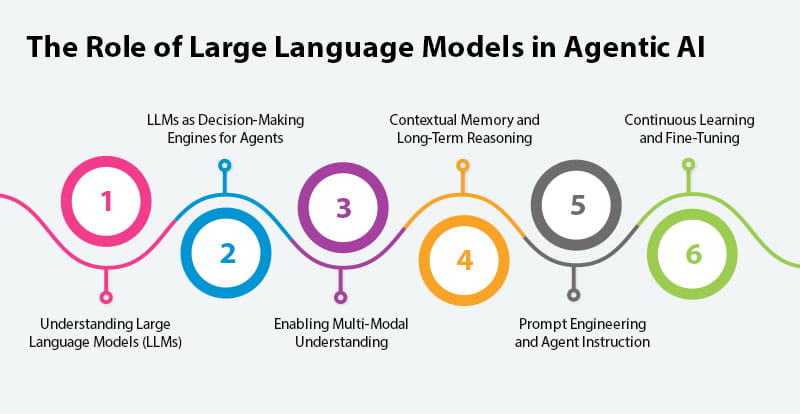Eliminating Repetitive Work with Agentic AI: A Comprehensive Guide to Smarter Automation | Part1
Repetitive work has long been a silent productivity killer for enterprises. From endless report generation to manual data entry, these routine tasks not only consume valuable time but also drain human creativity and innovation. Traditional automation has provided some relief, but it often falls short when flexibility, adaptability, and contextual awareness are needed. Enter Agentic AI - the next evolution in AI-powered automation.
This four-part guide aims to help you understand how Agentic AI can be used to eliminate repetitive work, transform business operations, and drive exponential productivity. In this first part, we will break down what Agentic AI really is, how it differs from existing technologies, how it identifies repetitive tasks, and why it matters for businesses across industries.
What is Agentic AI?
Definition and Core Concepts
Agentic AI refers to AI systems built around autonomous, goal-driven agents capable of perceiving their environment, planning actions, and making real-time decisions with minimal human supervision. Unlike traditional AI systems, which are task-based and require repeated prompting, Agentic AI systems operate with a high degree of independence, understanding goals and working toward outcomes through dynamic decision-making.
For example, think of an intelligent virtual agent that not only answers customer queries but also proactively follows up, escalates issues, and updates CRM data - all without manual programming for each step.
Components of Agentic AI Systems
The architecture of Agentic AI consists of:
- Perception Layer - Collects data from structured and unstructured sources like documents, APIs, sensors, and chat inputs.
- Planning Layer - Uses machine learning models and decision frameworks to map the best course of action in dynamic environments.
- Execution Layer - Performs tasks autonomously, monitors outcomes, and refines actions through feedback loops.
An enterprise-grade example is a self-operating financial reconciliation agent that detects inconsistencies in accounts, plans corrective actions, and executes adjustments after manager approval.
How Agentic AI Differs from Traditional Automation
RPA and traditional automation tools follow deterministic, rules-based logic. Change a condition, and the entire script breaks. Agentic AI, however, thrives in ambiguity. It uses large language models, neural networks, and contextual learning to adapt on the fly.
Picture a procurement system that adapts purchase approvals based on supplier ratings, market trends, and dynamic pricing instead of following static rules.
Real-World Examples of Agentic AI
- IT Service Management: Autonomous bots triaging incidents, categorizing them, and initiating resolution protocols.
- Customer Service: AI agents that handle multi-turn conversations, make decisions on refunds, and even draft follow-up emails.
- Logistics: Self-adjusting route planners that respond to traffic changes, weather data, and delivery priority.
Why Agentic AI Matters for Repetitive Work
Repetitive tasks sap employee morale and slow innovation. In fact, McKinsey reports that up to 30% of tasks in over 60% of occupations could be automated. Agentic AI does more than remove these burdens - it optimizes processes continuously, learns from errors, and contributes to higher operational efficiency.
Identifying Repetitive Work Across Departments
Why Identifying Repetitive Work is Foundational
Before any intelligent automation or Agentic AI implementation can take place, it’s crucial to identify repetitive, time-consuming tasks that drain resources without adding strategic value. These tasks often go unnoticed, buried under daily operations, but collectively, they impact productivity, employee satisfaction, and organizational agility. Identifying them across departments helps organizations strategically deploy intelligent agents where they will make the most significant impact.
Mapping Repetitive Tasks in Finance & Accounting
Finance teams often deal with large volumes of repetitive work - from invoice processing, reconciliation, and purchase order generation to manual data entry for tax filings. These processes are rule-based, require minimal decision-making, and are ideal candidates for automation through Agentic AI. Agents can help not only in automating these tasks but also in identifying anomalies, improving compliance, and supporting predictive forecasting.
Streamlining Repetitive Processes in Human Resources
HR departments manage various recurring tasks: employee onboarding paperwork, payroll processing, leave management, benefits administration, and recruitment-related communications. These manual processes are not only repetitive but also prone to human error. Deploying Agentic AI can transform HR by handling form submissions, automating documentation, scheduling interviews, and even conducting initial candidate screening with AI-powered conversational agents.
Automating Repetitive Workflows in Sales and Marketing
In sales and marketing, repetitive tasks include lead data entry, follow-up reminders, report generation, email sequencing, and campaign tracking. These low-value but necessary activities take up a significant portion of time that could otherwise be spent on customer engagement and strategic initiatives. Intelligent agents can autonomously manage CRM updates, trigger personalized emails, generate performance dashboards, and even recommend next best actions based on data.
Repetitive Tasks in Customer Support and Service
Customer support departments are overwhelmed by routine queries, ticket creation, categorization, and follow-ups. Intelligent agents and chatbots can handle FAQs, escalate priority issues, automatically close resolved tickets, and even predict customer churn by analyzing interaction patterns. This reduces agent fatigue and helps human teams focus on complex, empathy-driven problem-solving.
Manufacturing and Supply Chain Operations
In manufacturing and supply chain functions, repetitive tasks include inventory reconciliation, order tracking, shipment notifications, and procurement approvals. Agentic AI can automate these tasks, monitor real-time inventory levels, predict stock shortages, and trigger automatic reorders — enhancing operational efficiency and minimizing downtime.
Using Process Mining and Task Mining Tools
To systematically identify repetitive work across departments, organizations can leverage process mining and task mining technologies. These tools use data from enterprise systems (like ERP, CRM, and HCM platforms) to uncover hidden process inefficiencies, bottlenecks, and opportunities for automation. Combined with Espire’s discovery workshops, these tools form a data-driven foundation for targeted Agentic AI deployment.

The Role of Large Language Models in Agentic AI
Understanding Large Language Models (LLMs)
Large Language Models (LLMs) are AI systems trained on vast datasets consisting of text from books, articles, websites, and other sources. These models, such as GPT-4 and beyond, are capable of understanding and generating human-like text with contextual accuracy. In the context of Agentic AI, LLMs are the cognitive core - enabling intelligent agents to understand instructions, interpret complex queries, and generate coherent responses in natural language. Their deep contextual understanding and ability to process unstructured data make them essential for dynamic task execution.
LLMs as Decision-Making Engines for Agents
Agentic AI systems rely on LLMs not just for language processing, but also for interpreting instructions, evaluating conditions, and making informed decisions. For instance, when an agent is tasked with drafting an automated response or triggering workflows based on incoming communication, the LLM interprets both the context and intent. It also decides on appropriate next actions by weighing variables in real time - enabling agents to function autonomously with minimal human intervention.
Enabling Multi-Modal Understanding
Modern LLMs go beyond just text; they can process multiple data formats including audio, images, and structured data. This multi-modal capability allows agentic AI systems to handle more complex scenarios. For example, an agent could process a customer’s email request, cross-check the order status in a database, interpret an attached invoice, and then compose a detailed response - all autonomously. This multi-modal intelligence is crucial in enterprise environments where data comes in various formats.
Contextual Memory and Long-Term Reasoning
Agentic AI systems powered by advanced LLMs benefit from contextual memory, which allows them to maintain conversations over multiple exchanges without losing track of prior interactions. This makes them ideal for handling ongoing tasks and follow-ups across departments. Moreover, LLMs have improved long-term reasoning abilities, meaning agents can sequence actions and make decisions that unfold over several steps, rather than reacting to one-off commands.
Prompt Engineering and Agent Instruction
At the core of LLM-powered agents lies prompt engineering - crafting specific, structured inputs that guide the LLM in performing desired actions. Intelligent agents are often designed with dynamic prompts that can adapt based on situational data. For instance, an agent handling customer support queries may adjust its tone and depth of explanation based on customer sentiment analysis. Espire helps organizations develop these prompt architectures for scalable and precise agent deployments.
Continuous Learning and Fine-Tuning
One of the most powerful aspects of LLMs is their ability to learn from new data. While foundational models are pre-trained on massive datasets, enterprises can fine-tune these models on domain-specific data to enhance relevance and accuracy. For Agentic AI, continuous fine-tuning ensures agents become more aligned with business goals, industry language, and compliance requirements. Espire supports this process with model training frameworks that integrate enterprise-specific data, allowing agents to improve their responses and decision-making capabilities over time.
The Benefits of Eliminating Repetitive Work
Enhanced Productivity and Efficiency
When repetitive tasks are automated or delegated to intelligent agents, employees can focus on more strategic, creative, and high-value activities. Agentic AI handles routine processes like data entry, report generation, and transactional queries in real time and with zero fatigue. This significantly speeds up workflows and reduces turnaround times across departments, resulting in faster service delivery, quicker decision-making, and enhanced organizational efficiency.
Increased Employee Satisfaction and Retention
Repetitive, mundane work can lead to employee burnout and disengagement. By eliminating these tasks with the help of Agentic AI, organizations empower employees to focus on meaningful, skill-based work. Employees feel more valued and fulfilled when they can contribute strategically rather than spending their time on monotonous processes. This not only boosts morale but also improves retention and reduces attrition rates, fostering a motivated, future-ready workforce.
Reduced Operational Costs
Automating repetitive work leads to substantial cost savings. Businesses can optimize resource allocation, reduce dependency on large manual workforces for routine processes, and eliminate errors that often result in costly rework. Additionally, Agentic AI operates around the clock without incurring overtime or additional overhead, helping organizations save on labor costs and increase profitability.
Improved Accuracy and Compliance
Human errors in repetitive tasks - such as data entry mistakes, missed deadlines, or compliance oversights - can lead to financial penalties or reputational damage. Agentic AI systems operate with precision and consistency, reducing errors and maintaining complete audit trails for all actions taken. This not only ensures regulatory compliance but also builds trust among stakeholders and customers by delivering flawless, reliable outcomes.
Agility and Scalability Across Business Functions
Agentic AI helps organizations scale without adding additional human resources. Whether it’s handling increased volumes of customer inquiries, processing more transactions during peak seasons, or managing surges in order fulfillment, intelligent agents adapt to workloads effortlessly. This scalability ensures that businesses remain agile, responding quickly to market changes and customer needs without stress on operational capacity.
Competitive Advantage and Innovation Enablement
By eliminating repetitive work, organizations free up bandwidth for innovation. Teams can devote time to exploring new products, services, and strategies that differentiate them in the market. Additionally, the adoption of Agentic AI demonstrates technological maturity and future-readiness, positioning the business as a leader in digital transformation. Companies that embrace intelligent automation can outpace competitors with faster delivery, better customer experiences, and continuous improvement cycles.
Conclusion
Agentic AI is not just another buzzword - it’s the future of intelligent work. By identifying repetitive tasks across departments, enabling autonomous task discovery, and leveraging large language models, businesses can create agile, efficient, and future-ready operations.
At Espire, we’ve helped global enterprises eliminate repetitive work, increase efficiency by up to 40%, and free up thousands of productive hours.
In Part 2 of this guide, we will walk you through the step-by-step blueprint to design and implement Agentic AI systems that drive measurable business outcomes.
Don’t let repetitive work hold your business back. Connect with Espire to design intelligent, self-optimizing AI agents tailored to your unique needs. Reach out to us today and transform your enterprise productivity!



















